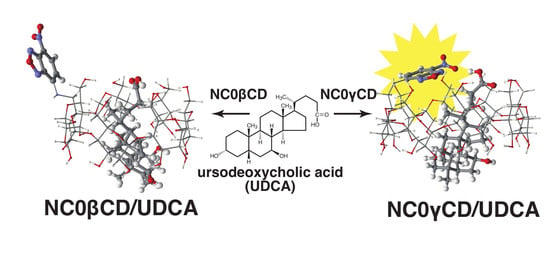Diversely Responsive Turn-On Fluorescent Cyclodextrin Chemosensors: Guest Selectivities and Mechanism Insights
Abstract
:1. Introduction
2. Materials and Methods
2.1. Materials
2.2. Measurements
2.3. Synthesis of NC0αCD, NC0βCD, and NC0γCD
2.4. Molecular Mechanics Calculations
2.4.1. α-CD, β-CD, and γ-CD
2.4.2. Ursodeoxycholic Acid (UDCA)
3. Results and Discussion
3.1. Guest Selectivities of NC0αCD, NC0βCD, and NC0γCD
3.2. The Structure of NC0βCD
3.3. Structure of the βCD/UDCA Complex
3.4. Structure of the NC0βCD/UDCA Complex
3.5. Structure of the NC0γCD/UDCA Complex
3.6. Structures of the NC0βCD/1-AdOH and NC0αCD/1-AdOH Complexes
4. Conclusions
Funding
Conflicts of Interest
References
- Czarnik, A.W. Fluorescent Chemosensors for Ion and Molecule Recognition; American Chemical Society: Washington, DC, USA, 1993. [Google Scholar]
- Desvergne, J.P.; Czarnik, A.W. Chemosensors of Ion and Molecule Recognition; Springer Science & Business Media: Berlin/Heidelberg, Germany, 2012. [Google Scholar]
- De Silva, A.P.; Gunaratne, H.Q.N.; Gunnlaugsson, T.; Huxley, A.J.M.; McCoy, C.P.; Rademacher, J.T.; Rice, T.E. Signaling Recognition Events with Fluorescent Sensors and Switches. Chem. Rev. 1997, 97, 1515–1566. [Google Scholar] [CrossRef] [PubMed]
- Lavigne, J.; Anslyn, E.V. Sensing A Paradigm Shift in the Field of Molecular Recognition: From Selective to Differential Receptors. Angew. Chem. Int. Ed. 2001, 40, 3118–3130. [Google Scholar] [CrossRef]
- Mirsky, V.M.; Yatsimirsky, A.K. Artificial Receptors for Chemical Sensors; Wiley-VCH: Weinheim, Germany, 2010. [Google Scholar]
- You, L.; Zha, D.; Anslyn, E.V. Recent advances in supramolecular analytical chemistry using optical sensing. Chem. Rev. 2015, 115, 7840–7892. [Google Scholar] [CrossRef] [PubMed]
- Wu, D.; Sedgwick, A.C.; Gunnlaugsson, T.; Akkaya, E.U.; Yoon, J.; James, T.D. Fluorescent chemosensors: The past, present and future. Chem. Soc. Rev. 2017, 46, 7105–7123. [Google Scholar] [CrossRef] [PubMed] [Green Version]
- Ueno, A.; Suzuki, I.; Osa, T. Host–guest sensory system for detecting a variety of organic compounds by variations in pyrene excimer and monomer fluorescence intensities. Chem. Lett. 1989, 18, 1059–1062. [Google Scholar] [CrossRef]
- Ikeda, H.; Nakamura, M.; Ise, N.; Oguma, N.; Nakamura, A.; Ikeda, T.; Toda, F.; Ueno, A. Fluorescent cyclodextrins for molecule sensing: Fluorescent properties, NMR characterization, and inclusion phenomena of N-dansylleucine-modified cyclodextrins. J. Am. Chem. Soc. 1996, 118, 10980–10988. [Google Scholar] [CrossRef]
- Ogoshi, T.; Harada, A. Chemical sensors based on cyclodextrin derivatives. Sensors 2008, 8, 4961–4982. [Google Scholar] [CrossRef] [PubMed] [Green Version]
- Ikeda, H. Fluorescent Cyclodextrins as chemosensors for molecule detection in Water. In Artificial Receptors for Chemical Sensors; Mirsky, V.M., Yatsimirsky, A.K., Eds.; Wiley-VCH: Weinheim, Germany, 2011; pp. 113–134. [Google Scholar]
- Ikeda, H. Chemosensors for water contaminants based on chromophore-appended cyclodextrins. In Environmental Chemistry for a Sustainable World; Fourmentin, S., Crini, G., Lichtfouse, E., Eds.; Springer: Berlin/Heidelberg, Germany, 2018; Volume 17, pp. 125–148. [Google Scholar]
- Szejtli, J. Cyclodextrin Technology; Springer Science and Business Media LLC: Berlin/Heidelberg, Germany, 1988. [Google Scholar]
- Szejtli, J.; Osa, T. Comprehensive Supramolecular Chemistry; Elsevier: Eastbourne, UK, 1996; Volume 3. [Google Scholar]
- Dodziuk, H. Cyclodextrins and Their Complexes-Chemistry, Analytical Methods, Applications; Wiley-VCH: Weinheim, Germany, 2006. [Google Scholar]
- Crini, G. Review: A history of cyclodextrins. Chem. Rev. 2014, 114, 10940–10975. [Google Scholar] [CrossRef] [PubMed]
- Diehl, K.L.; Anslyn, E.V. Array sensing using optical methods for detection of chemical and biological hazards. Chem. Soc. Rev. 2013, 42, 8596–8611. [Google Scholar] [CrossRef] [PubMed]
- Geng, Y.; Peveler, W.J.; Rotello, V.M. Array-based “chemical nose” sensing in diagnostics and drug discovery. Angew. Chem. Int. Ed. 2019, 58, 5190–5200. [Google Scholar] [CrossRef] [PubMed] [Green Version]
- Shanmugaraju, S.; Umadevi, D.; González-Barcia, L.M.; Delente, J.M.; Byrne, K.; Schmitt, W.; Watson, G.W.; Gunnlaugsson, T. “Turn-on” fluorescence sensing of volatile organic compounds using a 4-amino-1,8-naphthalimide Tröger’s base functionalised triazine organic polymer. Chem. Commun. 2019, 55, 12140–12143. [Google Scholar] [CrossRef] [PubMed]
- Ikeda, H.; Murayama, T.; Ueno, A. Skeleton-selective fluorescent chemosensor based on cyclodextrin bearing a 4-amino-7-nitrobenz-2-oxa-1,3-diazole moiety. Org. Biomol. Chem. 2005, 3, 4262–4267. [Google Scholar] [CrossRef] [PubMed]
- Ikeda, H.; Murayama, T.; Ueno, A. Bile acids-selective chemosensors based on NBD-amine-modified cyclodextrins. J. Incl. Phenom. Macrocycl. Chem. 2006, 56, 101–105. [Google Scholar] [CrossRef]
- Uchiyama, S.; Santa, T.; Okiyama, N.; Fukushima, T.; Imai, K. Fluorogenic and fluorescent labeling reagents with a benzodfurazan skeleton. Biomed. Chromatogr. 2001, 15, 295–318. [Google Scholar] [CrossRef] [PubMed]
- Ikeda, H.; Ueno, A. Fluorescent α-cyclodextrin as a chemosensor for halomethanes. Chem. Commun. 2009, 4281–4283. [Google Scholar] [CrossRef] [PubMed]
- Ikeda, H. Fluorescent cyclodextrins as chemosensors for the detection of cyclic and acyclic alcohols. J. Incl. Phenom. Macrocycl. Chem. 2017, 89, 71–75. [Google Scholar] [CrossRef]
- Halgren, T.A. Merck molecular force field. I. Basis, form, scope, parameterization, and performance of MMFF94. J. Comput. Chem. 1996, 17, 490–519. [Google Scholar] [CrossRef]
- Halgren, T.A. Merck molecular force field. II. MMFF94 van der Waals and electrostatic parameters for intermolecular interactions. J. Comput. Chem. 1996, 17, 520–552. [Google Scholar] [CrossRef]
- Crystal Structure Database; The Cambridge Crystallographic Data Centre: Cambridge, UK, 1965.
- Gotō, H.; Ōawa, E.; Yamato, M. How many conformers are there for small n-alkanes? Consequences of asymmetric deformation in GG’ segment. Tetrahedron 1993, 49, 387–396. [Google Scholar] [CrossRef]
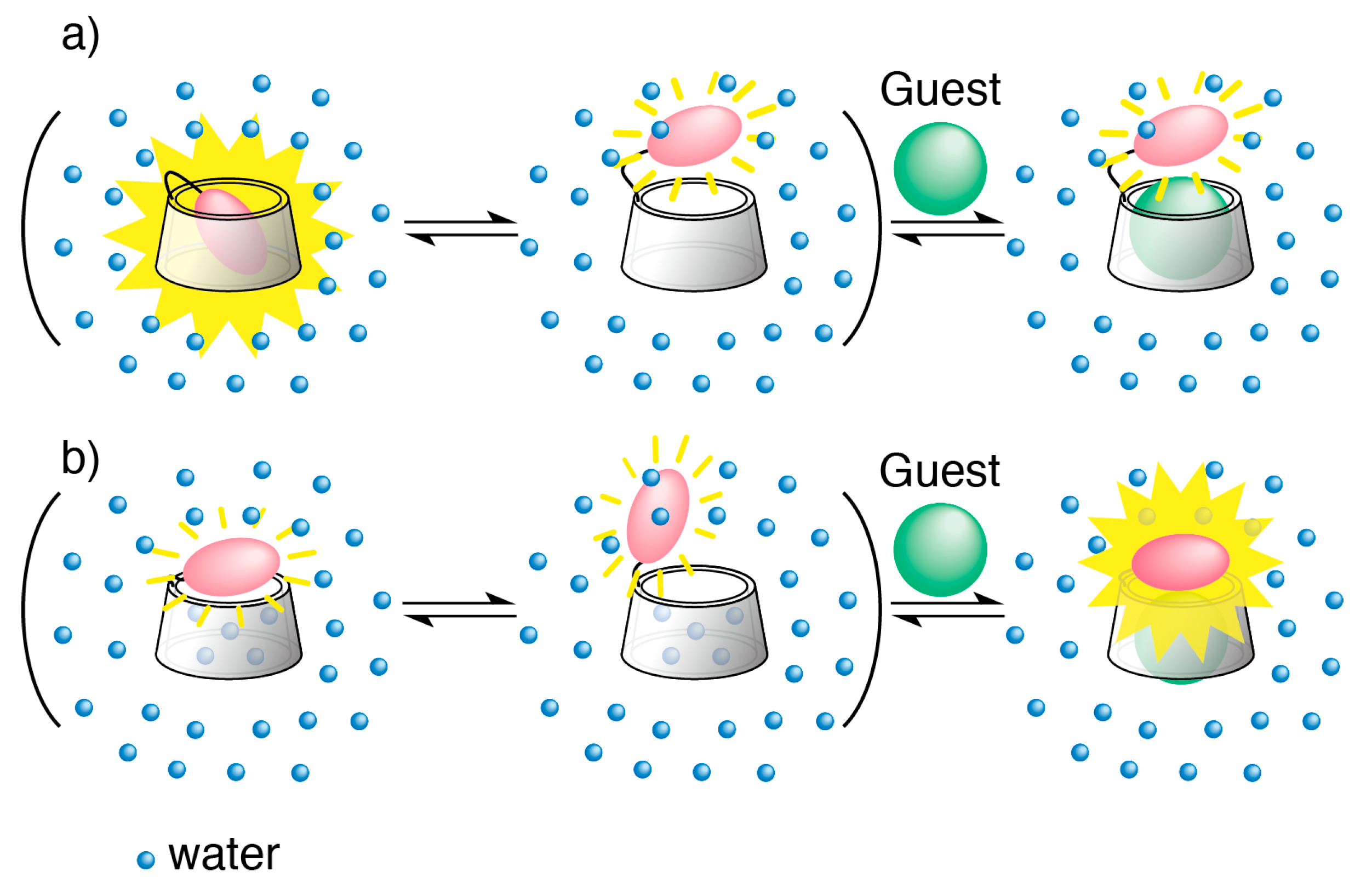
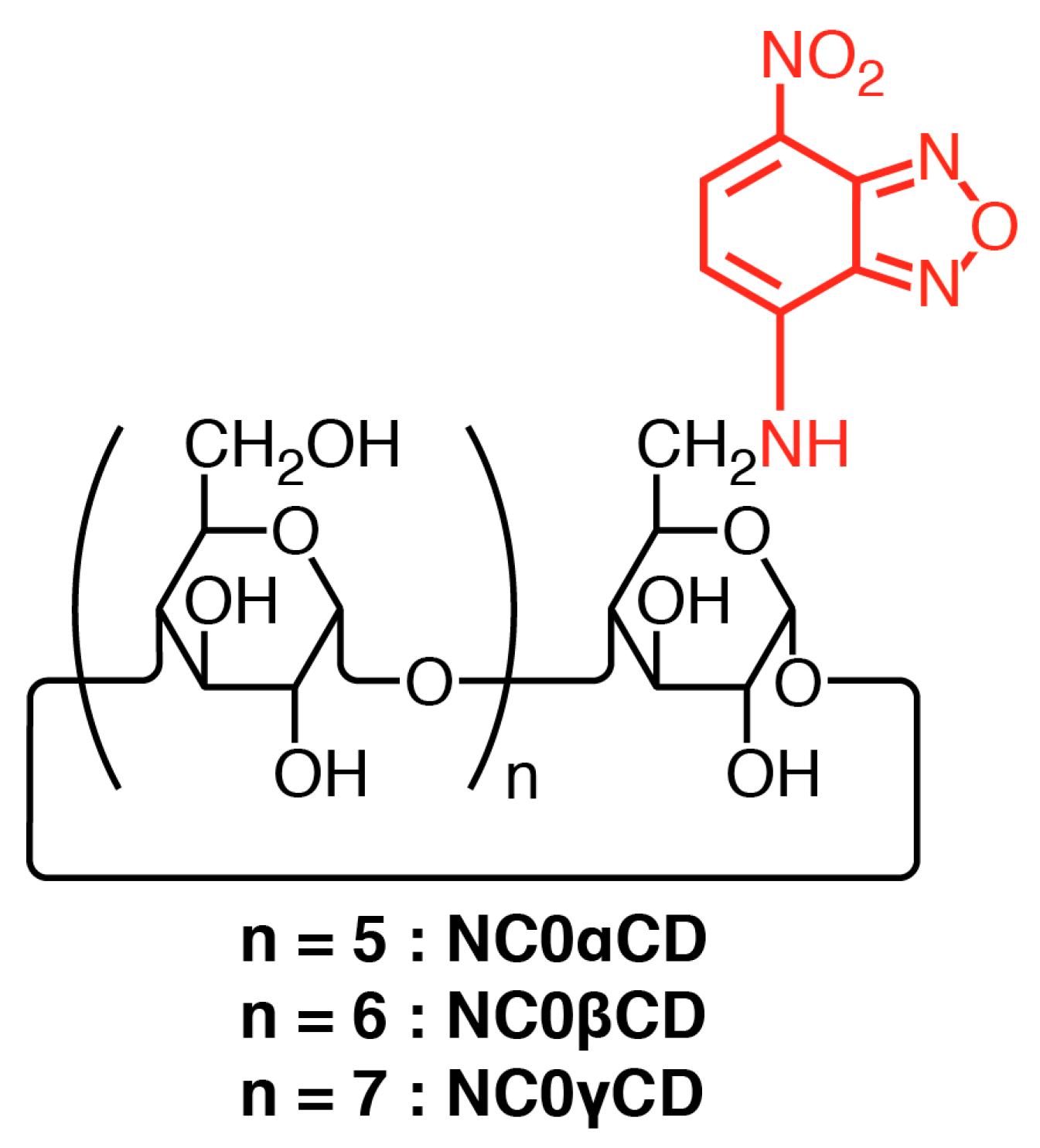
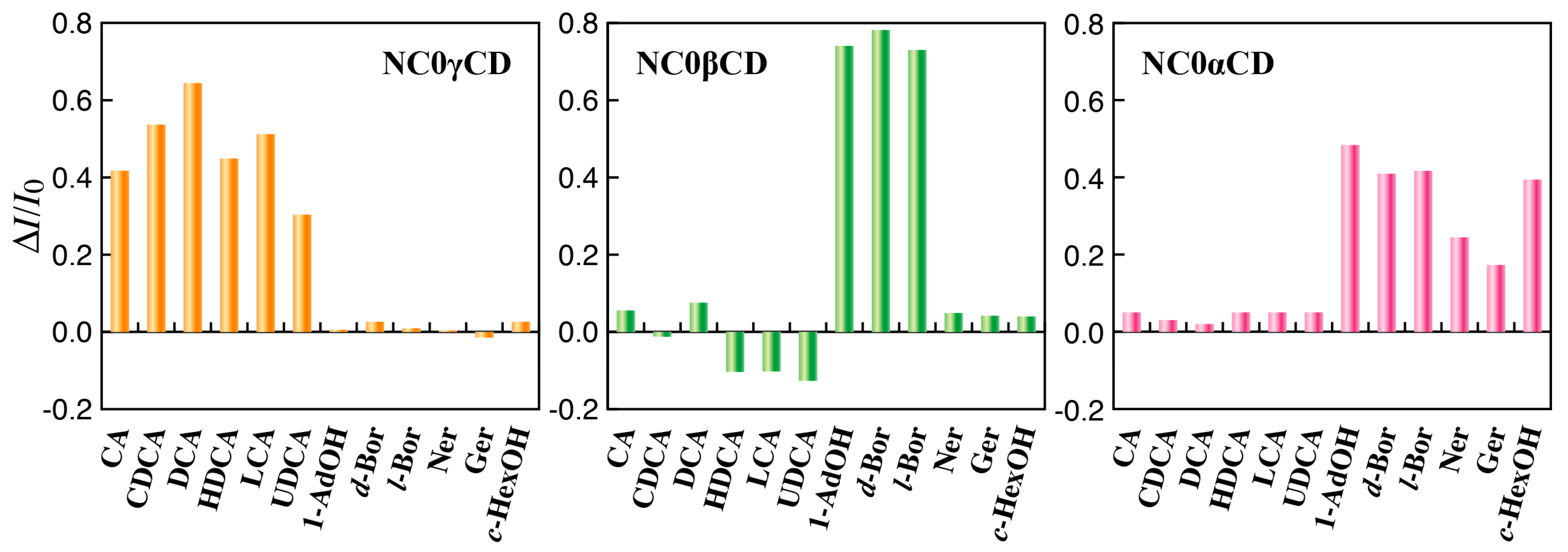
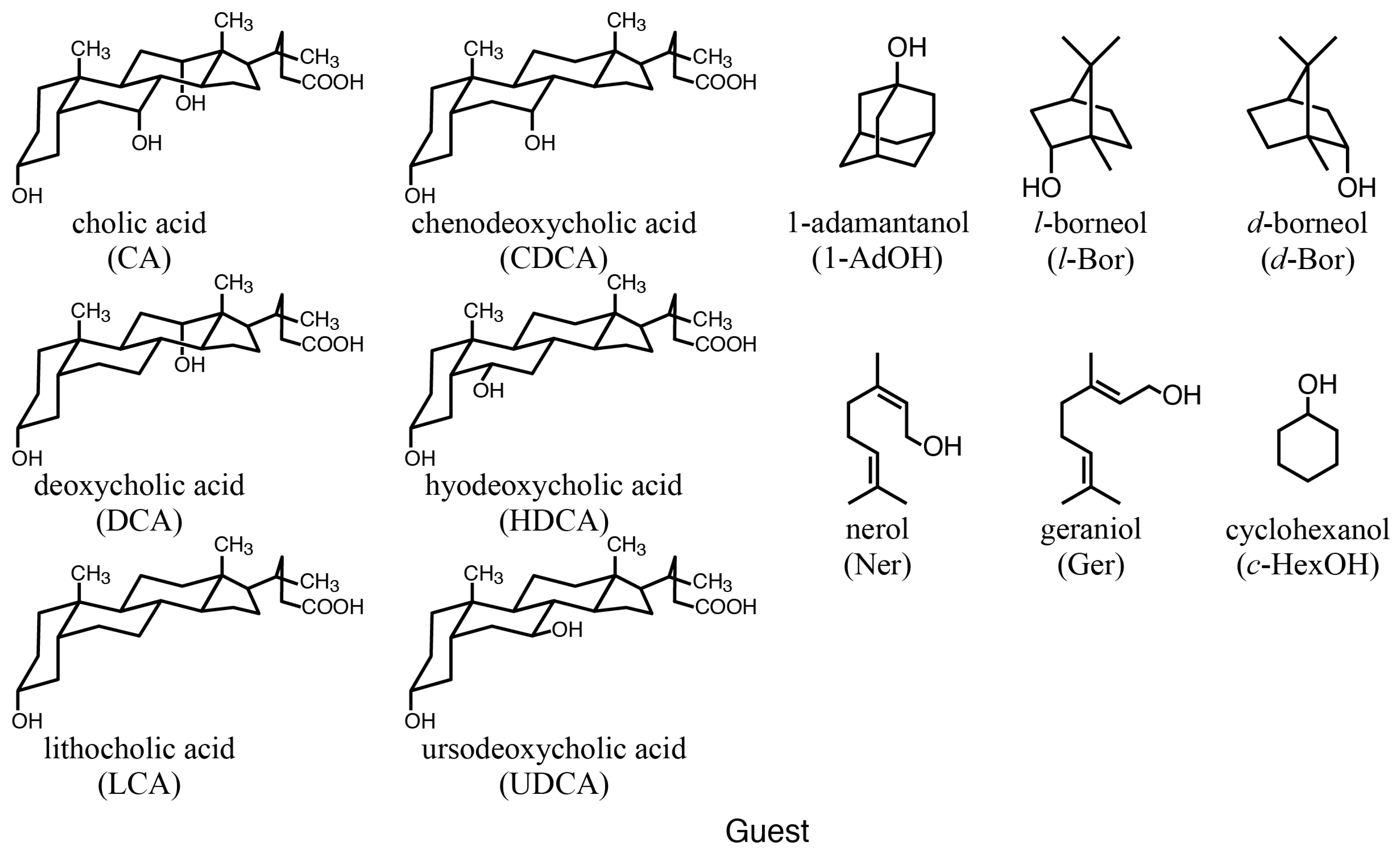
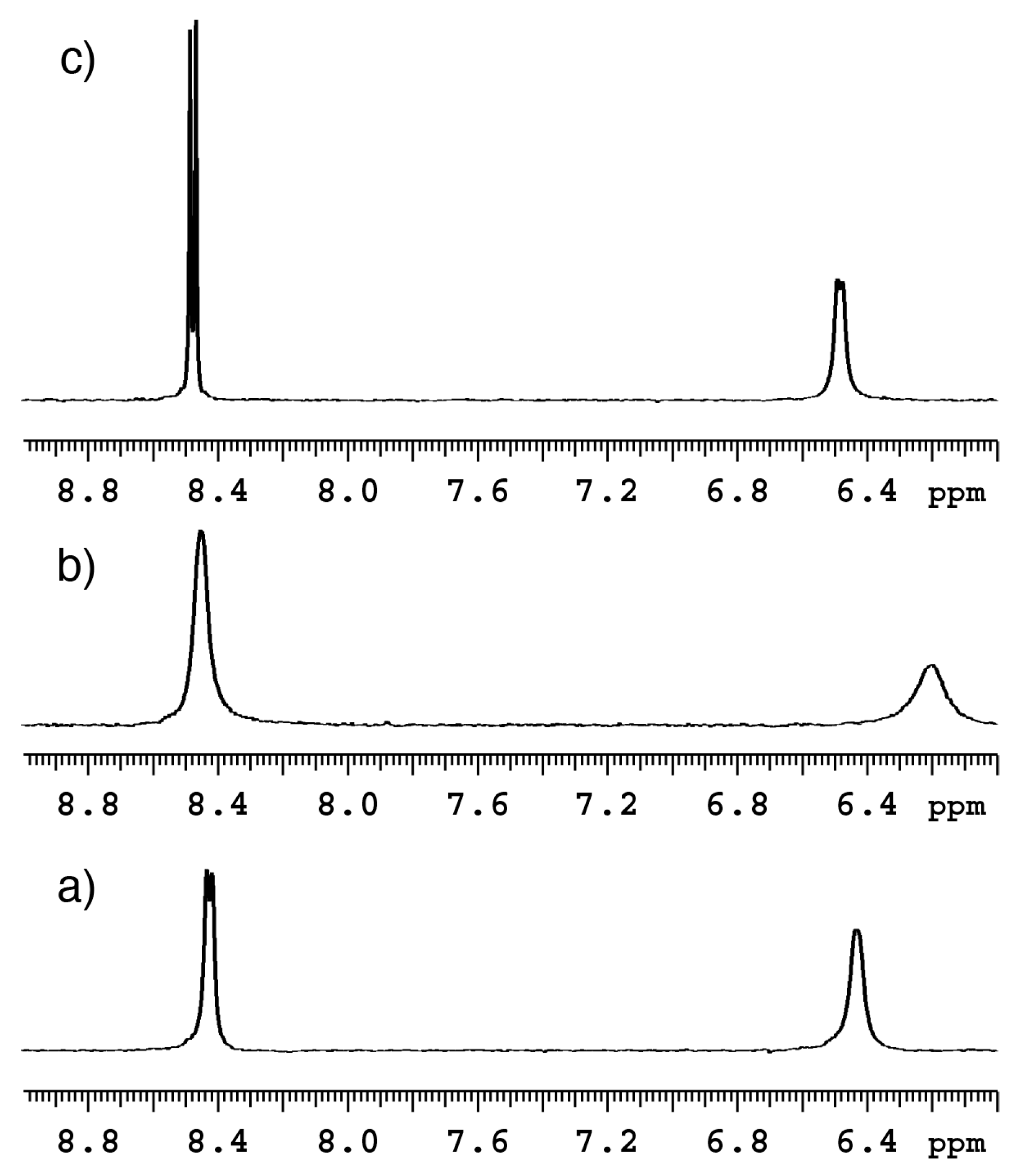

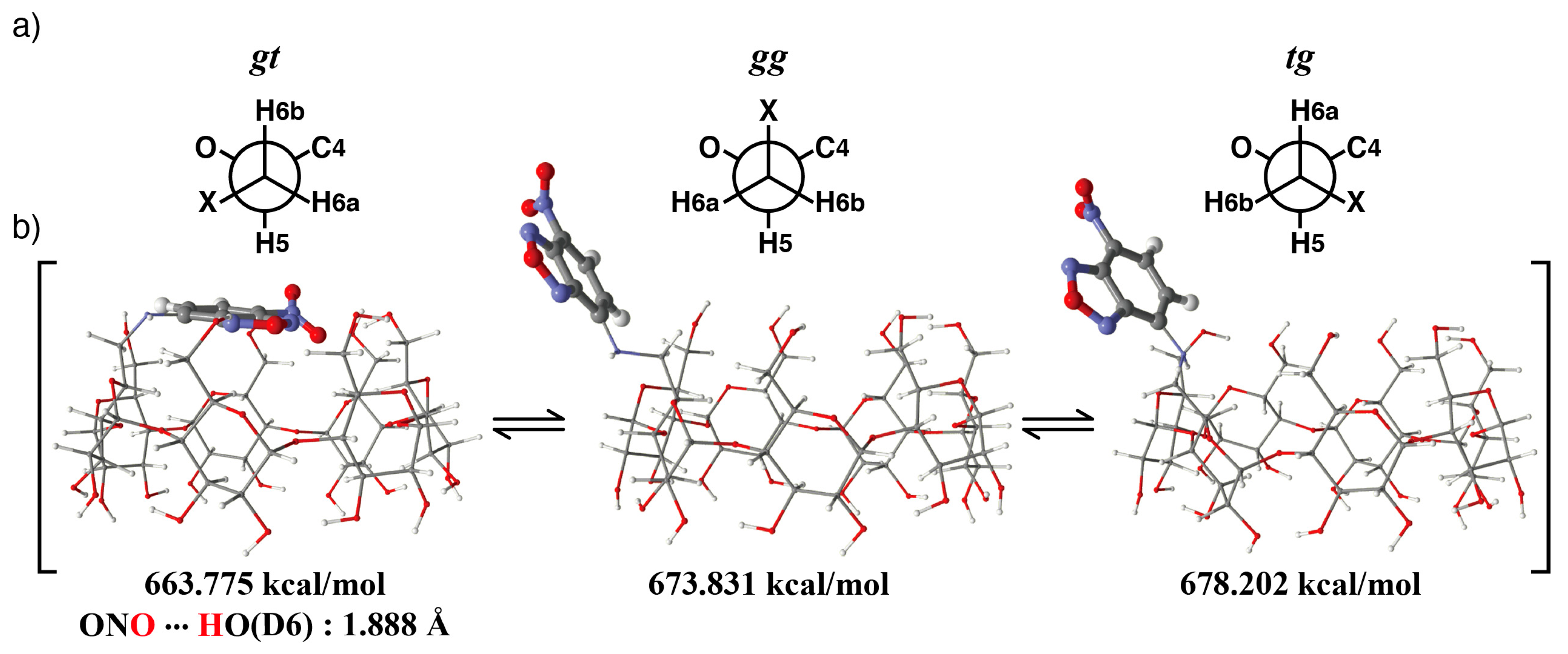





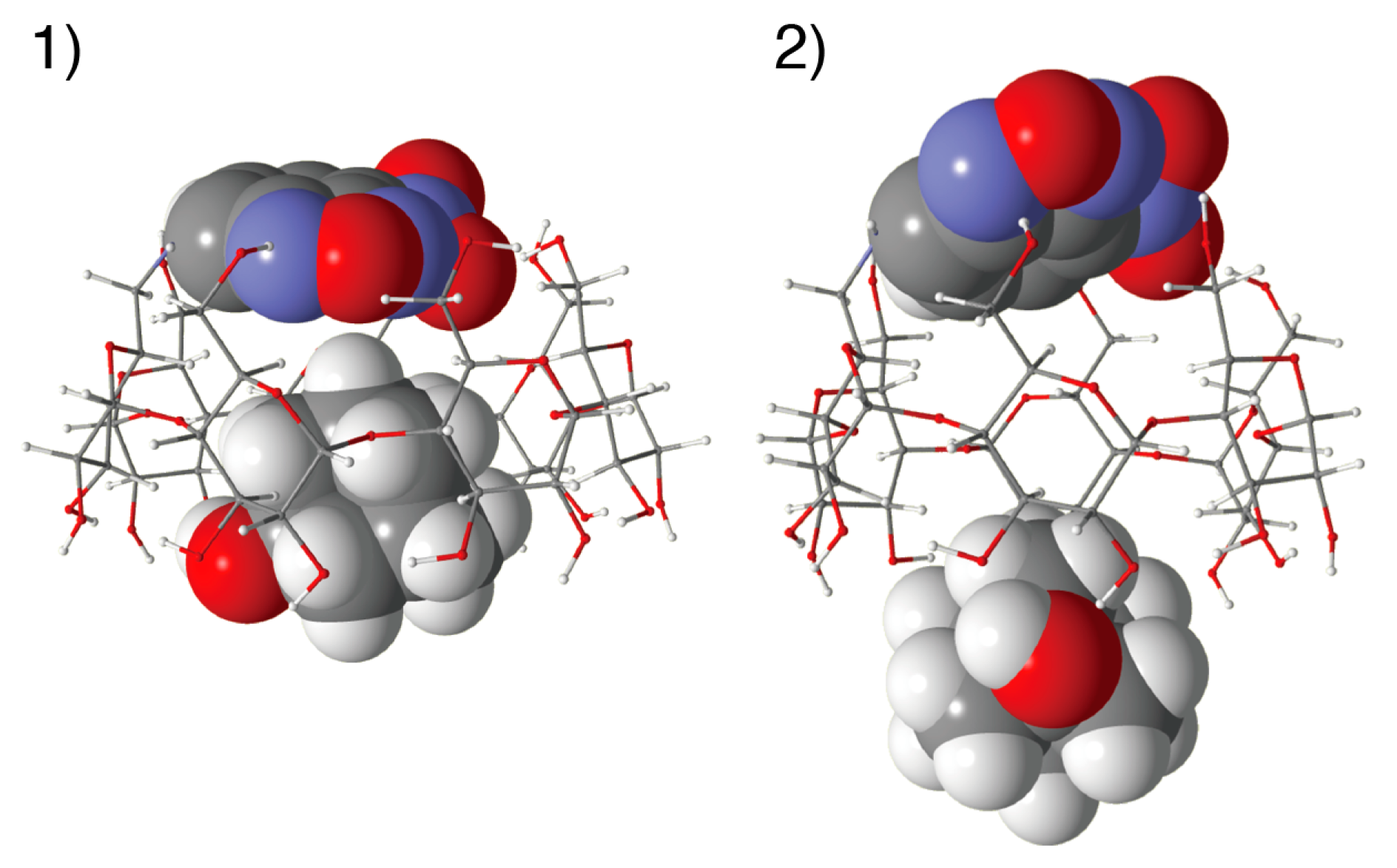
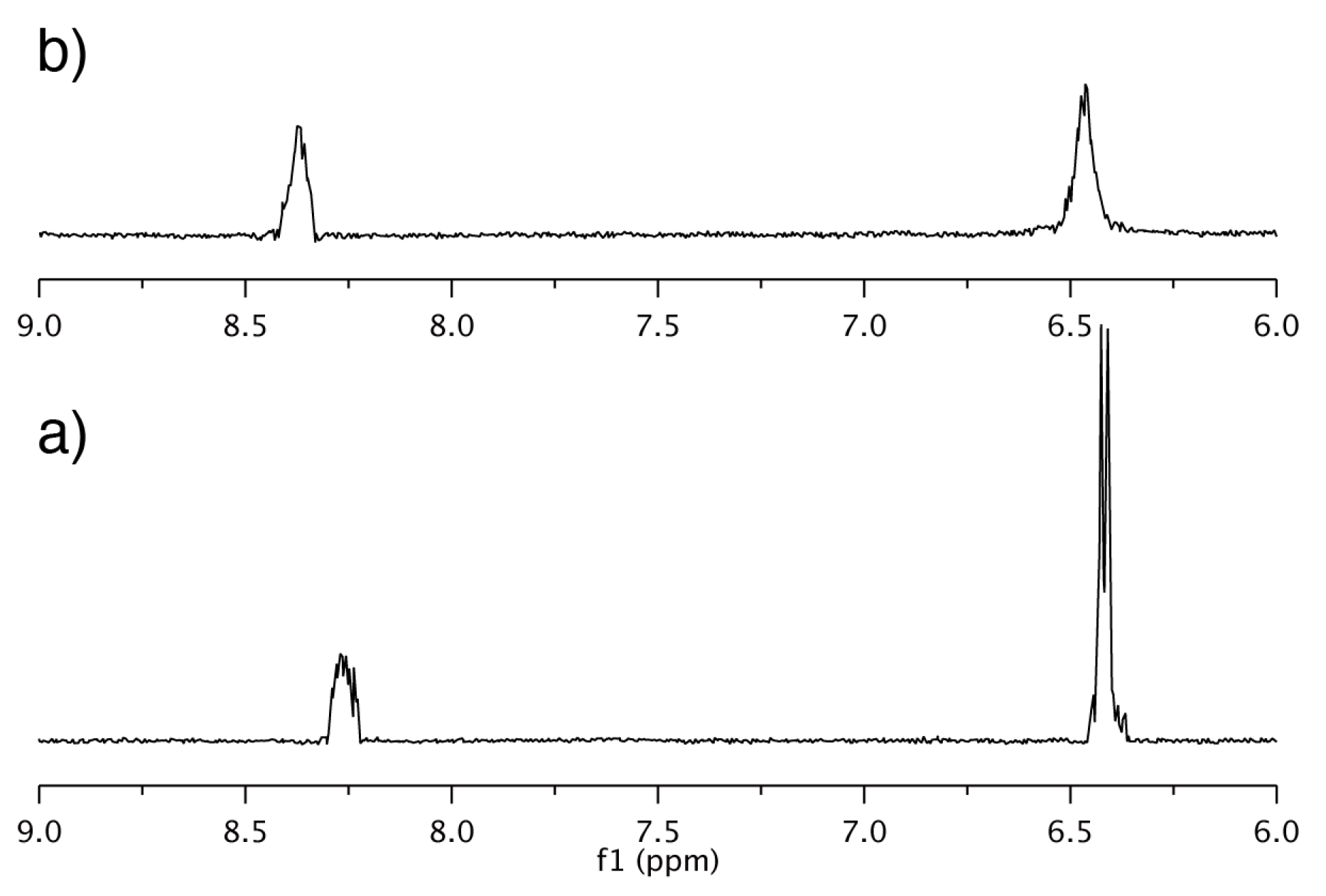
© 2020 by the author. Licensee MDPI, Basel, Switzerland. This article is an open access article distributed under the terms and conditions of the Creative Commons Attribution (CC BY) license (http://creativecommons.org/licenses/by/4.0/).
Share and Cite
Ikeda, H. Diversely Responsive Turn-On Fluorescent Cyclodextrin Chemosensors: Guest Selectivities and Mechanism Insights. Chemosensors 2020, 8, 48. https://doi.org/10.3390/chemosensors8030048
Ikeda H. Diversely Responsive Turn-On Fluorescent Cyclodextrin Chemosensors: Guest Selectivities and Mechanism Insights. Chemosensors. 2020; 8(3):48. https://doi.org/10.3390/chemosensors8030048
Chicago/Turabian StyleIkeda, Hiroshi. 2020. "Diversely Responsive Turn-On Fluorescent Cyclodextrin Chemosensors: Guest Selectivities and Mechanism Insights" Chemosensors 8, no. 3: 48. https://doi.org/10.3390/chemosensors8030048




